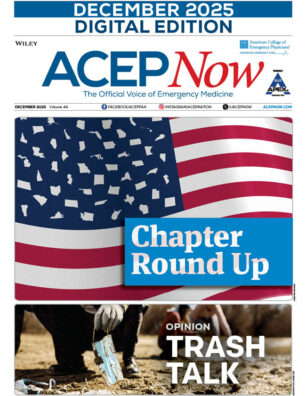
We are in the midst of the worst overdose crisis in American history, with greater than 100,000 deaths in the last year on record.1 Overdose is the leading cause of death among Americans 40-years-old and younger, accounting for more deaths than homicide, suicide, motor vehicle accidents, gun violence, and cancer.2 Within emergency medicine, we bear witness to this crisis first-hand, as we care for patients with opioid use disorder (OUD) during emergencies, post-overdose, for chronic concerns due to poor access to primary care, and for everything in between. These are our patients.
Explore This Issue
ACEP Now: April Digital 02-DWithin and outside of emergency medicine, there exists a growing body of research in public health, policy and pharmacology directed toward reducing the harms of this crisis. Among these evidence-based interventions are medications for opioid use disorder (MOUD), including opioid agonists like buprenorphine and methadone, which have indisputable benefits for morbidity and mortality.3,4 Despite extensive research supporting these interventions, fatal overdose rates continue to rise, largely due to inadequate implementation and poor patient access.5,6 From the emergency department (ED), we have the opportunity to impact individual patients and the public’s health by assuming a leading role in expanding access to MOUD for patients with OUD. Although buprenorphine research and use has grown significantly over the past decade, methadone continues to be an underutilized resource.
Methadone: A Primer on Efficacy & Patient Access
Methadone is a synthetic, full opioid receptor agonist with an average half-life of 24-hours, which allows for a once-daily dosing schedule. Methadone was first discovered in Germany in the 1930s and was approved in the US for analgesia in 1947, followed by approval as a medication for OUD in the 1960s. It has accumulated a significant evidence base, with clear data linking its use with decreased overdose risk, decreased harmful recreational use, decreased transmission of infectious disease, and increased treatment engagement when compared with non-pharmacologic treatment options alone.3,4 Despite this, methadone remains underutilized due to significant access barriers posed by prescribing restrictions.
Historically, methadone has been prescribed in the outpatient setting with required enrollment in an opioid treatment program (OTP). This presents a significant barrier due to the asymmetric geographic distribution of OTPs; one study estimated that just 20 percent of U.S. counties house an OTP.7 For patients who can access an OTP, they must attend in-person, daily, and consume their methadone under the direct supervision of clinic staff. With strict compliance, including time passed, perfect attendance, sequential negative urine tests, and “good behavior,” patients can eventually graduate to receive take-home doses. Take-home dosing usually plateaus at once-weekly, or in rare cases, once-monthly.8 This prescribing structure, intended to reduce methadone diversion and misuse, is uniquely restrictive compared to other opioids that carry the same risk and adverse event profiles. Critics highlight that this not only creates significant barriers for patients, but also is unique to the US—lax dispensing in peer countries does not correlate with increased rates of adverse events.9-11
In the ED, we are also limited in our ability to offer methadone to patients. We can refer patients to outpatient methadone clinics for treatment initiation, prescribe a missed methadone dose (often only when able to confirm with the patient’s methadone clinic during business hours), and administer a low dose – typically 20-40mg – for treatment of withdrawal. This poses challenges in our ability to care for patients with OUD, for example when patients present outside of business hours and their dose cannot be confirmed, or when a patient has withdrawal refractory to an initial low dose.
A Changing Landscape for Methadone Access
The COVID-19 pandemic necessitated unprecedented institutional changes in methadone prescribing to encourage safe social distancing. The Substance Abuse and Mental Health Services Administration (SAMHSA) permitted all patients 14-28 days of take-home doses, allowed for prescription continuation via telehealth, and set limits of the frequency of in-person random drug testing permitted. Policy implementation varied by state and OTP, but data suggests that take-home dosing was well received by patients and clinicians, and was not associated with an increase in overdose, diversion or ED utilization.12
This should prompt conversation and critical re-analysis among medical and public health policy stakeholders about methadone prescribing patterns. Increased methadone access by undoing previous prescribing restrictions is becoming more widely supported, including by the American Society of Addiction Medicine13 and by Nora Volkow MD, the current Director of the National Institute on Drug Abuse.14 New policies increasing methadone access have been proposed, namely the Modernizing Opioid Treatment Access Act (MOTAA), which would allow methadone prescription in the outpatient setting through pharmacies. If MOTAA passed, prescribing would be limited to addiction medicine specialists and primary care physicians affiliated with an OTP but would not extend to initiation in the ED.15 Loosened prescriber restrictions have also extended to the emergency setting with passage of the “Three-Day Rule,” which enables the on-site provision of three days of methadone to a patient not currently enrolled in an OTP, from one ED visit or inpatient hospitalization.16
Set against the backdrop of this rapidly evolving policy and prescribing landscape, academics, clinicians, harm reduction advocates, and patients with lived experience using methadone organized the inaugural Liberate Methadone Conference in September 2023, co-organized by the National Coalition to Liberate Methadone, National Survivors Union, and NYU’s Center for Opioid Epidemiology and Policy.* The conference recently published their proceedings, recommendations and a roadmap for change, which highlighted the importance of educating physicians working outside of addiction medicine about methadone to contribute toward improved outcomes for patients with OUD.17 The recommendations extend beyond MOTAA and post-COVID policy change, and include expanding telehealth-based access, supporting pharmacy-based distribution, reducing systemic barriers to prescription, and most notably for the emergency physician, giving “healthcare providers outside of OTPs…the necessary training to initiate and maintain methadone in their settings.”17
In emergency medicine, clinicians working to expand access to pharmacotherapy for OUD have primarily focused on buprenorphine induction. While this paradigm-changing work must continue, it omits our role in expanding methadone access, which would also serve these goals . For emergency physicians, reduced restrictions in methadone prescribing will better equip us to address pain control and withdrawal in the ED, allowing us to guide our prescribing based on clinical judgment and evidence rather than by restrictive policies. Researchers could have the opportunity explore methadone as has already been done for buprenorphine – to fill our knowledge gaps, answering questions about how we could initiate methadone from the ED, and how this could change ED utilization, overdose rates, and outpatient care retention.
When asked what emergency physicians could learn from the Liberate Methadone Conference and movement, conference organizer Noa Krawczyk PhD said: “Emergency clinicians interact with patients who could benefit from methadone every day, so are a critically needed voice in this movement; their involvement can ensure that a revitalized, patient-centered system effectively integrates methadone treatment across hospital and outpatient care settings.” With this message in mind, emergency physicians, researchers, policy experts, and educators must use our voice to ensure ongoing methadone policy changes best utilize EDs to increase access and clinical outcomes for patients with OUD.
Footnotes
* Funding for this conference provided by the National Institute on Drug Abuse, Pew Charitable Trusts, FORE Foundation, Vital Strategies, and Bloomberg Philanthropies.
Dr. Hughes is a resident at The Mount Sinai Hospital & Elmhurst Hospital Center.
Dr. Chen is a resident at The Mount Sinai Hospital & Elmhurst Hospital Center.
Dr. Khatri is an assistant professor of emergency medicine at the Icahn School of Medicine at Mount Sinai.
References
- Drug Overdose Deaths: Facts and Figures. NIDA. 2024 Aug1.
- Centers for Disease Control and Prevention. wisqars.cdc.gov/animated-leading-causes/2.
- Mattick RP, Breen C, Kimber J, Davoli M. Methadone maintenance therapy versus no opioid replacement therapy for opioid dependence. Cochrane Database Syst Rev. 2009 Jul 8;(3):CD0022093.
- Larochelle MR, Bernson D, Land T, et al. Medication for Opioid Use Disorder After Nonfatal Opioid Overdose and Association With Mortality: A Cohort Study. Ann Intern Med. 2018 Jun 19;169:137-1454.
- Nguyen CMT, Kubiak G, Dixit N, Young SA, Hayes JR. Evaluating Barriers to Opioid Use Disorder Treatment From Patients’ Perspectives. PRiMER. 2024 Feb 19;8:115.
- Madras BK, Ahmad NJ, Wen J, Sharfstein J, et al. Improving Access to Evidence-Based Medical Treatment for Opioid Use Disorder: Strategies to Address Key Barriers Within the Treatment System. NAM Perspectives. 2020. Discussion Paper, Washington, DC6.
- Joudrey PJ, Edelman EJ, Wang EA. Drive Times to Opioid Treatment Programs in Urban and Rural Counties in 5 US States. JAMA. 2019 Oct 1;322(13):1310-13127.
- Substance Abuse and Mental Health Services Administration. Federal Guidelines for Opioid Treatment Programs. 2015 Mar8.
- Australian Government: Department of Health and Aged Care. National Guidelines for Medication-Assisted Treatment of Opioid Dependence. 2014 Apr9.
- Priest KC, Gorfinkel L, Klimas J, Jones AA, Fairbairn N, McCarty D. Comparing Canadian and United States opioid agonist therapy policies. Int J Drug Policy. 2019 Dec;74:257-26510.
- United Kingdom Department of Health and Social Care. Drug Misuse and Dependence: UK Guidelines on Clinical Management. 201711.
- Panwala V, Joudrey P, Kowalski M, Bach P, Amram O. Changes to methadone maintenance therapy in the United States, Canada, and Australia during the COVID-19 pandemic: A narrative review. J Subst Use Addict Treat. 2023 Sep;152:20908612.
- American Society of Addiction Medicine. Modernize it and Standardize It. 202513.
- Volkow N. Guest Editorial: To Address the Fentanyl Crisis, Greater Access to Methadone Is Needed. The ASAM Weekly. 202414.
- Markey EJ. S.644 – Modernizing Opioid Treatment Access Act. 202315.
- Davis J. Important Update on the “Three-Day” Rule for Administering Medications to Treat Opioid Use Disorder. ACEP. 2022 Apr16.
- National Coalition to Liberate Methadone, National Survivors Union, NYU Langone Center for Opioid Epidemiology and Policy (COEP). Liberating Methadone: A Roadmap for Change: Conference Proceedings and Recommendations. 2024 Jun17.
Pages: 1 2 | Multi-Page


No Responses to “Liberate Methadone: An Introduction for the Emergency Medicine Physician”